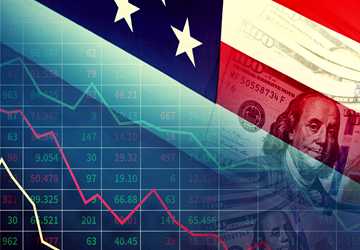How Global Economic Trends Influence U.S. Stock Markets?
Author: sana
Have you ever felt lost in the maze of global economics and U.S. stocks? You're not alone. The world's economy is a tangled web, making it challenging to see how overseas events shake Wall Street.
This confusion isn't just frustrating—it's risky. Miss a key global trend, and you could watch your investments nosedive. Worse, you might sit on the sidelines while others cash in on opportunities you didn't spot.
But don't worry—we've got your back. This post will break down the significant global economic trends and show how they ripple through U.S. stock markets. You'll have a clearer picture of this complex dance when you're done reading.
Ready to become a savvier investor? Let's dive in and unravel how the world's economy pulls the strings of U.S. stocks.
5 Key Global Economic Trends Influencing U.S. Stock Markets
These trends keep Wall Street on its toes and can make or break your portfolio. Ready to connect the dots? Let's dive into the five key trends shaping U.S. stocks.
1. International Trade Policies
Trade policies are like the rules of the global marketplace. When they change, it's felt from Main Street to Wall Street. Take the U.S.-China trade war, for instance. One day, everything's business as usual. The next, tariffs are flying, and tech stocks are on a rollercoaster ride.
But it's not all drama. Sometimes, new trade deals open doors. Remember NAFTA? It reshaped North American trade. Now, its successor, USMCA, is doing the same. These agreements can mean new markets and more significant profits for U.S. companies.
The ripple effects? They're everywhere. Auto stocks surge on relaxed regulations, and farm exports boom with new agricultural agreements. It's a constant shuffle, and savvy investors always watch for the next significant shift.

2. Foreign Exchange Rates
Why do some U.S. companies care so much about the dollar's value? It's all about forex, baby. When the dollar is strong, U.S. goods get pricier abroad. That can hurt exporters but help importers.
Take a company like Apple. A strong dollar might hurt its overseas sales, but it could also make its Asian suppliers cheaper. It's a delicate balance.
What moves currencies? Everything from interest rates to political stability. Economic data releases, central bank meetings, and even tweets from world leaders can send currencies spinning.
For investors, it's crucial to keep an eye on these forex fluctuations. They can make or break a company's quarterly earnings faster than you can say "exchange rate."
3. Global Interest Rates
Interest rates are the puppet strings of the financial world. When the Federal Reserve moves, markets dance. But here's the kicker: it's not just about the Fed anymore. The European Central Bank and the Bank of Japan play a part in this global symphony.
For example, when interest rates rise in Europe, it can attract capital away from U.S. markets. That could mean less demand for U.S. stocks and bonds. Conversely, if rates stay low abroad, the U.S. might look more attractive to international investors.
Remember the negative interest rates in Japan and parts of Europe? That sent shockwaves through global markets. It's a brave new world, and understanding these global rate dynamics is critical to navigating it.
4. Economic Growth in Major Economies
The world is a prominent place, but when it comes to economic growth, some players matter more than others. These economic powerhouses in China, the E.U., and Japan can make waves that reach Wall Street.
When China sneezes, U.S. stocks catch a cold. Just look at how Chinese growth forecasts can send commodity prices (and related stocks) soaring or plummeting. And let's remember Europe. A recession there can hit U.S. multinationals hard.
It's all interconnected. Global GDP growth tends to sync with U.S. market trends, so investors hang on to every word of economic reports worldwide. A surprise in German manufacturing data or Japanese consumer spending can ripple through U.S. markets in the blink of an eye.
5. Geopolitical Events
Politics and markets are like oil and water—they don't mix well, but they're constantly swirling around each other. Elections, conflicts, and policy shifts can all send shockwaves through the market.
Take Brexit. Who would've thought a U.K. referendum could cause such a stir on Wall Street? But it did, sending markets into a tizzy as investors tried to figure out what it meant for global trade and finance.
Or consider the oil market. A single statement from OPEC can send energy stocks on a wild ride. And let's wait even to get started on how elections can shake things up.
The point is, in today's world, geopolitics and markets are joined at the hip. Intelligent investors keep one eye on the ticker and the other on the news headlines.
How to Analyze the Impact of Global Trends on U.S. Stocks
Now that we've covered the critical global trends, let's roll up our sleeves and get practical. How can you, as an investor, actually use this information? Don't worry; I've got you covered.
Here's a step-by-step guide to help you connect those global dots to your investment decisions.
1. Gathering Global Economic Data
First things first: you need good data. But where to find it? Start with the heavy hitters like the IMF and World Bank. They're goldmines of global economic info. Central banks are another go-to source. The Fed, ECB, and Bank of Japan publish regular reports packed with juicy economic data.
But here's the thing: data is only as good as current. Make sure you're getting the latest figures. Set up alerts, bookmark key websites, and create a data dashboard if you feel fancy.
Once you've got your data, organize it. Spreadsheets are your friend here. Group data by country, sector, or whatever makes sense for your analysis. The key is to spot trends and patterns. That's where the real insights come from.
2. Assessing Market Sentiment
Numbers are great, but emotions also move markets. That's where market sentiment comes in. It's like taking the pulse of the investment world. Sentiment surveys are an excellent place to start. For example, the AAII Investor Sentiment Survey can quickly read whether investors feel bullish or bearish.
Remember the media's role. Financial news outlets can shape sentiment big time. Keep an eye on headlines, but dig deeper, too. Analyst reports can offer more nuanced views on market mood.
Want to get fancy? Check out sentiment analysis tools. These use A.I. to gauge sentiment from social media and news sources. It's like having a finger on the market's emotional pulse 24/7.
3. Monitoring Key Indicators
Now we're getting to the meat and potatoes: critical economic indicators. GDP growth rates, inflation figures, employment data - these are the big guns of financial analysis. They're like vital signs for the global economy.
But here's the trick: it's not just about the numbers but what they mean. A rise in inflation might sound bad, but it could signal a growing economy. Context is key.
Take the recent U.S. jobs report. Substantial employment numbers seem tremendous, but this could also mean the Fed keeps interest rates high. See how it's all connected?
Pro tip: create an economic calendar. Mark key data release dates. It'll help you anticipate market moves and avoid nasty surprises.

4. Evaluating Sector-Specific Impacts
Here's where things get interesting. Global trends don't hit all sectors equally. A strong dollar might hurt U.S. exporters but benefit companies that import raw materials. It's all about connecting the dots.
Start by mapping out how different sectors relate to global trends. Tech stocks might be more sensitive to trade policies, while energy stocks often dance to the tune of geopolitical events. Build a sector impact matrix to get it organized.
Remember the chip shortage a while back? It hammered auto stocks but gave a boost to semiconductor makers. That's the kind of sector-specific impact you're looking for.
Keep an eye on sector rotations, too. When global trends shift, money often moves between sectors. Spotting these moves early can give you a natural edge in the market.
It's Time to Think Globally, Invest Locally
You've got the tools. Now, put them to work. The global economy is still strong, and your investment strategy should continue.
Start small. Pick one global trend and see how it might affect your portfolio. Then, gradually expand your analysis. Before you know it, you'll be spotting opportunities others miss.
Remember, the most successful investors don't just react to the market - they anticipate it. By understanding global trends, you're giving yourself a natural edge.
Don't let another day pass by ignoring the bigger picture. Your future self will thank you for starting now. After all, in today's interconnected world, thinking globally isn't just bright—it's essential for investment success.







